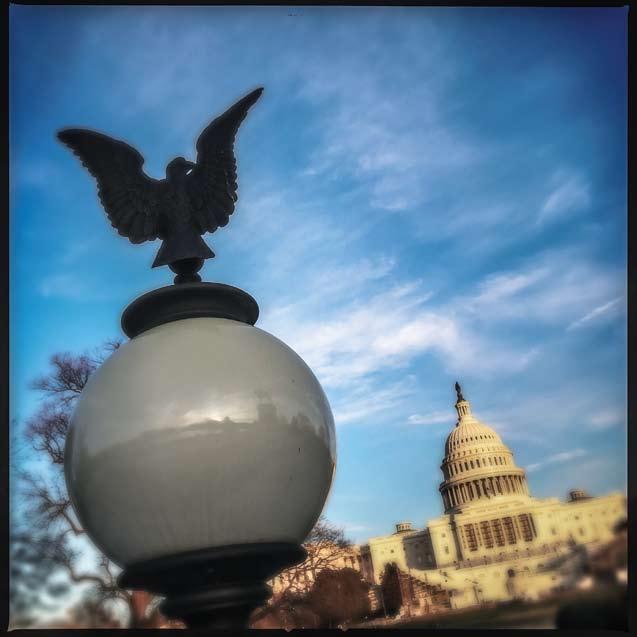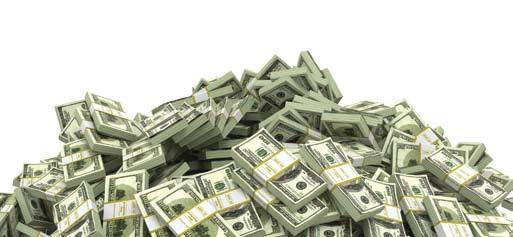
10 minute read
Loose Lips: Who knew what in
The Insurrection Will Be Televised The week that pro-Trump extremists stormed the U.S. Capitol
By Mitch Ryals
Advertisement
@MitchRyals For Mayor Muriel Bowser, the planning started in December. On New Year’s Eve, Bowser requested support of 340 unarmed D.C. National Guard troops for the pro-Trump gatherings scheduled for the following week. By Monday, Jan. 4, federal officials approved activation of 340 guard members, most of whom were on traffic duty.
Also on Jan. 4, attorneys with the Office of the Attorney General convened a closed briefing to tell D.C. councilmembers about all the ways President Donald Trump The Capitol Building on Jan. 7
could interfere with law enforcement in D.C. The OAG produced a two-page memo, first reported by Buzzfeed News, after Trump threatened to take over the Metropolitan Police Department in the midst of racial justice protests last summer. The memo is not a public document, but an attorney familiar with its contents described it to LL.
It lays out several scenarios. The memo cites the D.C. law that gives the president the authority to take control of MPD in “special conditions of an emergency nature.” It talks about how, unlike in states, where governors control the National Guard, the D.C. National Guard can be used for various functions in the District without the direct consent of the mayor. The third section describes the president’s power to deputize federal law enforcement agencies, such as the Bureau of Prisons, to operate in D.C. under other federal agencies that already exist here, such as the U.S. Park Police. The memo explains how the Insurrection Act gives the president the authority to call armed troops to suppress a rebellion. Under the law, originally passed in 1807, the president would first have to “issue a proclamation ordering insurgents to disperse within a limited time.” If that doesn’t work, he or she can send in the armed forces.
The law was last used in 1992, after four White police officers were acquitted in the beating of Rodney King in Los Angeles. The memo’s final section talks about how the president can use the National Guards of other states in the District to protect federal property.
On Jan. 5, the day before pro-Trump extremists stormed the U.S. Capitol in a violent and horrific attempt to stop Congress from affirming President-elect Joe Biden’s victory, Bowser said she had everything under control. In a letter to Acting U.S. Attorney General Jeffrey Rosen, Secretary of the Army Ryan McCarthy, and Acting Secretary of Defense Christopher Miller, Bowser wrote that MPD had all the help it needed for the planned demonstrations on Jan. 6. The letter describes coordination between MPD and the U.S. Capitol Police, U.S. Park Police, and the Secret Service, as well as logistical help from the D.C. National Guard.
Bowser’s letter referenced unidentifiable federal agents “deployed in the District of Columbia without proper coordination,” during last summer’s protests, and said their presence could complicate and confuse her officers trying to police the pro-Trump crowds expected in D.C. last week.
“To be clear, the District of Columbia is not requesting other federal law enforcement personnel and discourages any additional deployment without immediate notification to, and consultation with MPD if such plans are underway,” Bowser wrote.
At his rally on Wednesday, Jan. 6, Trump pledged to “never give up,” in front of a crowd of mostly unmasked supporters gathered on the Ellipse and encouraged them to “fight like hell.” Trump’s lawyer and abettor, RudyGiuliani, suggested a “trial by combat.” (The House of Representatives filed articles of impeachment against Trump on Monday,alleging that his comments incited the riot that followed. As of Jan. 7, acting United States Attorney for D.C. Michael Sherwin did not rule out the possibility of seeking criminal charges against both men.)
The first wave of insurrectionists left Trump’s rally and marched down Pennsylvania Avenue NW toward the Capitol before 1 p.m. There, they met a few measly barriers and a severely under prepared U.S. Capitol Police force. Around 1 p.m., Capitol Police Chief Steven Sund called Acting MPD Chief Robert Contee, who sent 100 officers to help, according to the Washington Post’s account.
Shortly after, Sund called House Sergeant at Arms Paul Irving and Senate Sergeant at Arms Michael Stenger to ask for an emergency declaration and D.C. National Guard support. Sund told the Post that he asked for Guard support six times before it was finally granted about two hours later.
At 1:34 p.m., Bowser joined a call with McCarthy and asked for an unspecified number of additional forces, according to a timeline assembled by the Department of Defense, and just before 2 p.m., the violent mob entered the Capitol.
By 2:26 p.m., Sund was on a conference call with the Pentagon and D.C. government officials, pleading for more help. Lt. Gen. Walter Piatt, director of the Army staff, said he did not like the optics of the National Guard standing in a police line at the Capitol, Sund told the Post, though Piatt has disputed that. But by 3:04 p.m., Miller, the acting defense secretary, verbally authorized activation of the full D.C. Guard. Guard members didn’t arrive at the Capitol until 5:40 p.m. By then, four people were already dead; a fifth, Capitol Police Officer Brian Sicknick, would die later in a hospital. Capitol Police declared the building secure at 8 p.m., but it took the help of MPD, National Guard, and state and local police agencies in jurisdictions surrounding D.C.
Ashli Babbitt was shot and killed by a Capitol Police officer when she tried to enter the Speaker’s Lobby. Three people— Kevin Greeson, Roseanne Boyland, and Benjamin Philips—died after suffering medical emergencies on Capitol grounds, MPD Chief Contee said. Their causes of death have not been released publicly. Sicknick was injured “while physically engaging with protesters.” Law enforcement sources told the AP he was hit in the head with a fire extinguisher, though officials have not confirmed that account. Another Capitol Police officer, Howard Liebengood, who was on duty during the riot, died by suicide after the events.
Contee has heaped praise on his officers for quickly coming to the aid of Capitol Police. More than 50 MPD officers were injured, and video circulating online shows insurrectionists beating one MPD officer with a flagpole on the Capitol steps.
At 11 p.m., Bowser held a press conference announcing the extension of a public emergency until Jan. 21, the day after Biden is slated to be sworn in on the Capitol steps.
What specific intelligence did the local government have?
When the dust settled, District officials wasted little time pointing the finger at the federal government.
“I don’t think MPD is where we should be pointing fingers,” D.C. Council Chairman Phil Mendelson said last Friday. “I think it would be fair for the Council, in oversight hearings, to press public safety officials on
‘what can you be doing to make sure we’ve got the bases covered?’”
He noted that MPD does not have jurisdiction on federal property, including the Capitol grounds, but “they could block protesters on Constitution Avenue, on the way up to the Capitol,” he said. “I’m not sure how viable that is, but law enforcement can be creative when they want to.”
Contee said the Capitol Police likely miscalculated the threat, but he has declined to say what information his department was aware of in the lead-up to the insurrection. On WAMU’s The Politics Hour last Friday afternoon, Contee said MPD had no “specific intelligence where someone says, ‘Hey, I’m going to place a bomb’ or ‘I’m going to do this.’”
But the evidence, as many have pointed out, was hiding in plain sight.
Sund, it appears, was aware of at least some of the threats to storm the Capitol and attack members of Congress, as he indicated in his interview with the Post. But those threats have appeared on social media in the past as well, he said.
This week, the Post uncovered a Jan. 5 report from the FBI that warned about extremists coming to D.C. for “war,” and foreshadowing the violence that would unfold at the Capitol. Steven D’Antuono, head of the FBI’s Washington office, said Tuesday that the report was shared with a joint terrorism task force, which includes MPD.
Additionally, Mary McCord, the legal director of the Institute for Constitutional Advocacy and Protection at Georgetown University, has worked with a researcher at the Digital Forensic Research Lab to track online extremism and paramilitary groups. Through that work, she’s provided daily reports on online chatter about potential threats of violence on Jan. 6 to local and federal law enforcement, she said. She did not send the reports directly to Capitol Police.
“Not only did they probably have this information through their own sources, but other outside groups were providing some measure of it,” McCord says. “Whether they thought that threat was credible, that’s their own decision.”
How did councilmembers react?
At-Large Councilmember Robert White asked D.C. Attorney General Karl Racine whether Trump could be charged with inciting a riot. In a letter sent Jan. 7, White asks Racine for an analysis of whether Trump could be held criminally responsible and of any changes the Council could make to the District’s rioting statue “to address future incitement of riots and terrorism.”
Recently, D.C.’s riot law was used to charge hundreds of protesters arrested last summer during the unrest related to racial injustice and police brutality. MPD only arrested about 60 people involved in the insurrection, most for violating Bowser’s 6 p.m. curfew.
Racine said this week that his office is taking up White’s request. In addition to Trump, Racine is evaluating whether Donald Trump Jr., Giuliani, and Alabama Rep. Mo Brooks (R) could face criminal charges under D.C. law. The code defines riot as a “public disturbance involving an assemblage of 5 or more persons which by tumultuous and violent conduct or threat thereof creates grave danger of damage or injury to property or persons.”
The House’s articles of impeachment accuse Trump of “inciting violence against the government of the United States.”
Ward 6 Councilmember Charles Allen held a hearing last year on a bill to update the riot statute, but it never passed out of committee. The bill died in January with the end of the two-year Council period. It’s unclear whether Allen will reintroduce it, according to a spokesperson for his office.
What does this mean for D.C. statehood?
The day after the insurrection, Bowser laid out her priorities for the new, Democratcontrolled Congress. At the top of the list is getting a D.C. statehood bill to Biden’s desk in the first 100 days. Bowser’s inability to mobilize the D.C. National Guard without approval of the federal government, an authority that all governors have, forced the issue to the national consciousness.
But even with Democrats controlling the White House and Congress, D.C. statehood is not a guarantee. Supporters would need 60 Senate votes to overcome a filibuster.
The House approved a bill granting statehood last summer, but the bill died in the Republican-held Senate. D.C. Del. Eleanor Holmes Norton (D), D.C.’s non-voting representative, re-introduced the bill this year.
What does it mean for the inauguration?
President-elect Joe Biden will take the oath of office on Jan. 20, despite evidence that Trump’s extremist supporters are again planning to show up for the event.
On Sunday, Bowser asked the Secretary of the Interior not to issue any public gathering permits and to cancel any that were previously issued. She also asked the Department of Homeland Security to expand the National Special Security Event, which allows officials to create a perimeter around the Capitol, from Jan. 11 to Jan. 24. The acting secretary agreed to expand the designation from Jan. 13 to Jan. 19.
Bowser stopped short of asking for a cancelation because “that event, in my view, should be public,” she said Monday. Bowser joined Maryland Gov. Larry Hogan (R) and Virginia Gov. Ralph Northam (D) in encouraging people to watch the inauguration virtually. Up to 15,000 National Guard troops will be stationed in D.C. for the event.
“If I’m scared of anything, it’s for our democracy,” Bowser said Monday. “Because we have very extreme factions in our country that are armed and dangerous.”
OVER $3.3 MILLION OVER $3.3 MILLION IN CASH PRIZES! IN CASH PRIZES!


LET’S PLAY!





DC Scratcher games may continue to be sold even when all the top prizes have been claimed.














